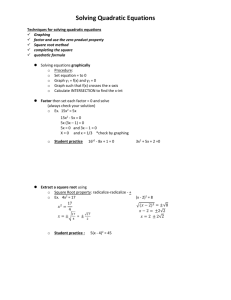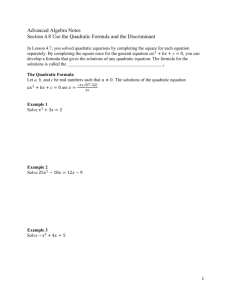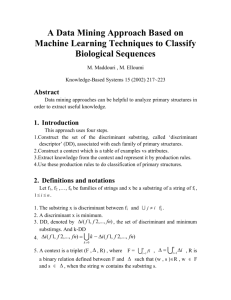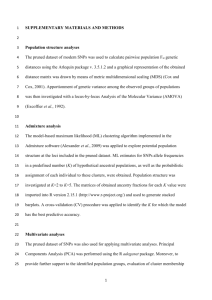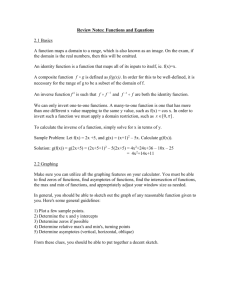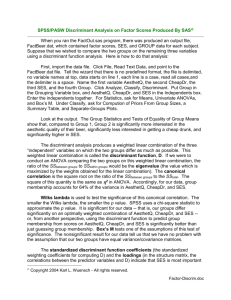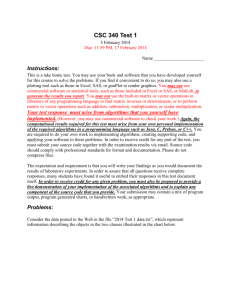A pace of weight 1 modular forms attached to totally real cubic
advertisement
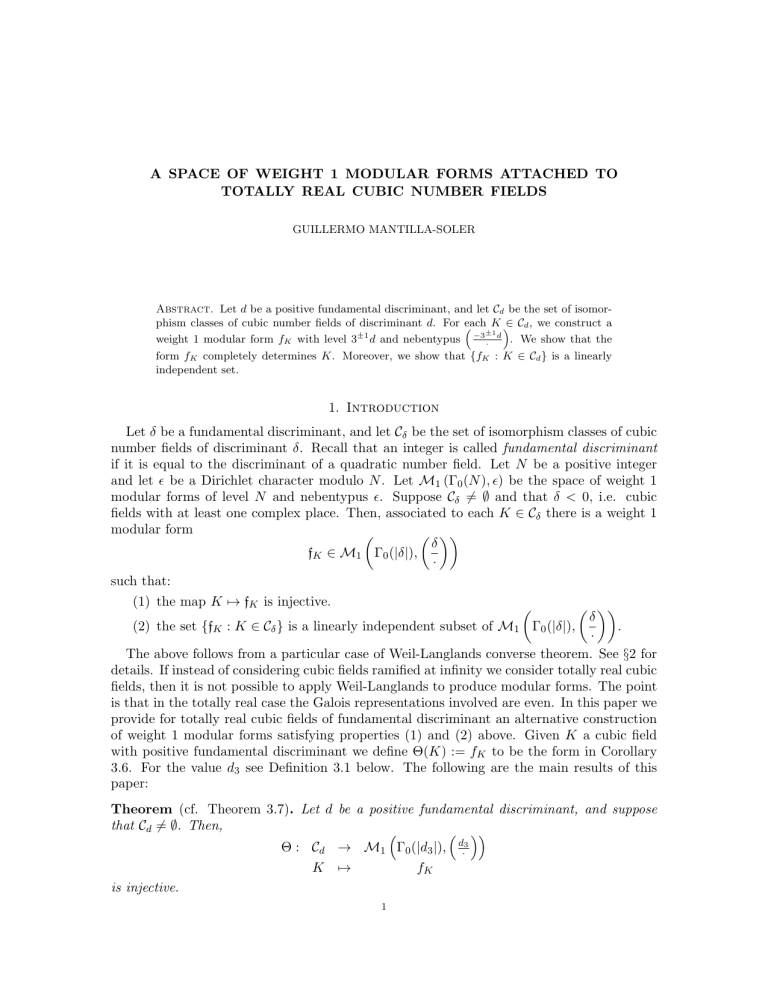
A SPACE OF WEIGHT 1 MODULAR FORMS ATTACHED TO
TOTALLY REAL CUBIC NUMBER FIELDS
GUILLERMO MANTILLA-SOLER
Abstract. Let d be a positive fundamental discriminant, and let Cd be the set of isomorphism classes of cubic number fields of discriminant d. For each
±1K ∈ Cd , we construct a
weight 1 modular form fK with level 3±1 d and nebentypus −3 · d . We show that the
form fK completely determines K. Moreover, we show that {fK : K ∈ Cd } is a linearly
independent set.
1. Introduction
Let δ be a fundamental discriminant, and let Cδ be the set of isomorphism classes of cubic
number fields of discriminant δ. Recall that an integer is called fundamental discriminant
if it is equal to the discriminant of a quadratic number field. Let N be a positive integer
and let be a Dirichlet character modulo N . Let M1 (Γ0 (N ), ) be the space of weight 1
modular forms of level N and nebentypus . Suppose Cδ 6= ∅ and that δ < 0, i.e. cubic
fields with at least one complex place. Then, associated to each K ∈ Cδ there is a weight 1
modular form
δ
fK ∈ M1 Γ0 (|δ|),
·
such that:
(1) the map K 7→ fK is injective.
δ
(2) the set {fK : K ∈ Cδ } is a linearly independent subset of M1 Γ0 (|δ|),
.
·
The above follows from a particular case of Weil-Langlands converse theorem. See §2 for
details. If instead of considering cubic fields ramified at infinity we consider totally real cubic
fields, then it is not possible to apply Weil-Langlands to produce modular forms. The point
is that in the totally real case the Galois representations involved are even. In this paper we
provide for totally real cubic fields of fundamental discriminant an alternative construction
of weight 1 modular forms satisfying properties (1) and (2) above. Given K a cubic field
with positive fundamental discriminant we define Θ(K) := fK to be the form in Corollary
3.6. For the value d3 see Definition 3.1 below. The following are the main results of this
paper:
Theorem (cf. Theorem 3.7). Let d be a positive fundamental discriminant, and suppose
that Cd 6= ∅. Then,
Θ : Cd → M1 Γ0 (|d3 |), d·3
K 7→
fK
is injective.
1
2
GUILLERMO MANTILLA-SOLER
Corollary (cf. Corollary 3.9). Let d be a positive fundamental discriminant,
and suppose
d3
that Cd 6= ∅. Then Θ(Cd ) is a linearly independent subset of M1 Γ0 (|d3 |), ·
.
2. Weight 1 forms attached to non-totally real cubic fields.
We briefly recall how from Weil-Langlands for S3 one can obtain a family of linearly independent weight 1 modular forms parametrized by the set of isomorphism classes of cubic
fields of a fixed negative discriminant.
e
Let L be a cubic number field with discriminant δ < 0, which is fundamental, and let L
be its Galois closure.
e
L
H∼
=Z/3Z
L
S3
√
Q( δ)
Q
e
By identifiying S3 with Gal(L/Q),
and considering the irreducible 2-dimensional representation of S3 , one obtains an irreducible dihedral representation of ρL : Gal(Q/Q) → GL2 (C).
Such a representation is induced by a non-trivial representation√of H. Since d is a fundamene is contained in the Hilbert class field of Q( δ). Thus, by the conductor
tal discriminat L
formula for induced representations, we have that ρL has conductor |δ|. From the
√ above
diagram we see that det(ρL ) is the inflation of the non-trivial character of Gal(Q(
δ)/Q).
In other words, for all primes p not dividing d we have that det(ρL (Frobp )) = pδ . In parX an
be the Artin L-series attached
ticular, ρL is an odd representation. Let L(s, ρL ) =
ns
n=1
X
to ρL and let fL =
an q n be the q-expansion of L(s, ρL ). It follows from [8, Theorem 1]
n=1
that
δ
fL ∈ M1 Γ0 (|δ|),
.
·
Moreover, each fL is a normalized cuspidal eigenform.
Remark 2.1. Notice that ζLe (s) = L2 (s, ρL )ζQ(√δ) .
Theorem 2.2. The following is injective:
Φ : Cδ → M1 Γ0 (|δ|),
L 7→
fL
δ
·
Furthermore, Φ(Cδ ) is a linearly independent subset of M1 Γ0 (|δ|),
δ
·
.
Proof. Let L, L1 be two cubic fields, up to isomorphism class, of discriminant δ. Then
Φ(L) = Φ(L1 ) ⇐⇒ L(s, ρL ) = L(s, ρL1 ).
e and L
f1 are arithmetically equivalent (see [6]).
It follows, see Remark 2.1, that the fields L
e are both Galois over Q we have that L
e ∼
f1 and consequently L and L1
Since L and L
= L
MODULAR FORMS ARISING FROM TOTALLY REAL CUBIC FIELDS
3
define the same element in Cδ . Since a set of normalized cuspidal eigenforms not containing
pairs of linear dependent forms is a linearly independent set, the linearly independence of
Φ(Cδ ) follows from the injectivity of Φ.
The construction above gives a natural subspace of
δ
M1 Γ0 (|δ|),
,
·
which has a canonical basis indexed by cubic fields of discriminant δ.
Definition 2.3. We call this space Vδ := SpanC Φ(Cδ ) the δ-cubic space.
Remark 2.4. Notice
that Vδ is actually a Hecke invariant subspace of the cuspidal subspace
of M1 Γ0 (|δ|), δ· .
3. Totally real cubic fields
The main goal of this paper is to exhibit a canonical subspace of a space of weight 1
modular forms that is parametrized by the set of isomorphism classes of cubic fields of a
fixed fundamental discriminant. In case that the fields have ramification at infinity, the
construction is classic and it is explained in §2. In this section we show how to construct
such a subspace for cubic fields with no ramification at infinity i.e., totally real cubic fields.
0 ⊂ K be the set of integral
3.1. Main construction: Let K be a number field and let OK
elements with zero trace. The map
0
t0K : OK
x
→
Z
7
→
trK/Q (x2 )
defines a quadratic form with corresponding bilinear form
TK (x, y) = trK/Q (xy)
0
OK
.
Definition 3.1. Let d be a non-zero integer. The 3-reflection d3 of d is the integer defined
3d
.
by d3 := −
gcd(3, d)2
Proposition 3.2. Let K be a cubic field with fundamental discriminant d. Then,
tK :=
t0K
2gcd(3, d)
is a primitive integral binary quadratic form of discriminant d3 .
Proof. If 3 - d this is precisely [3, Corollary 5.4]. Otherwise, the result follows from [3,
Theorem 6.4].
It turns out that for a totally real cubic field K the form tK completely characterizes the
isomorphism class of K.
Theorem 3.3. [3, Theorem 6.5] Let d be a positive fundamental discriminant and let K
and L be two cubic fields of discriminant d. Then,
K∼
= L ⇐⇒ tK ∼
= tL ,
where the second ∼
= refers to equivalence under the natural GL2 (Z)-action.
4
GUILLERMO MANTILLA-SOLER
Definition 3.4. Let K be a totally real cubic field with fundamental discriminant d. Let
X
q tK (x)
fK (z) :=
0
x∈OK
where q = e2πiz , and z lies in the upper half plane.
We have associated to K, or more generally to its isomorphism class, a theta series given
by the quadratic form tK . The following classic result of Schoeneberg [7] gives us some
information about fK .
Theorem 3.5 (Schoenberg). Let Q be a positive definite, integral quadratic form of dimension 2k, and discriminant ∆. Let
X
q Q(x)
θ(Q, z) :=
x∈Z2k
be the theta series associated to Q. Then,
∆
θ(Q, z) ∈ Mk Γ0 (|∆|),
.
·
See [5, Theorem 20-20+ ].
Corollary 3.6. Let K be a totally real cubic field with fundamental discriminant d. Then,
d3
fK ∈ M1 Γ0 (|d3 |),
·
Proof. Since tK is a binary form of discriminant d3 the result is a particular case of Schoenberg’s Theorem.
Let d be a positive fundamental discriminant, and recall that Cd denotes the set of isomorphism classes of cubic number fields with discriminant d. The following is the key result
in the construction of a basis for the space of modular forms mentioned at the beginning of
this section.
Theorem 3.7. The map
Θ : Cd → M1 Γ0 (|d3 |), d·3
K 7→
fK
is injective.
Proof. Let K and L be two isomorphism classes in Cd . Suppose that Θ(K) = Θ(L). Since
binary positive definite forms are determined up to integral equivalence by their theta series
(see [9]) we have that the forms tK and tL are equivalent. Thus thanks to Theorem 3.3 we
have that K and L are the same.
We add a proof of the following simple fact for the lack of a suitable reference.
Lemma 3.8. Let Q and Q1 be two integral binary quadratic forms of the same discriminant.
If there exists a prime p which is represented by Q and Q1 , then the forms are equivalent.
Proof. We may assume that Q(x, y) = px2 + bxy + cy 2 , and that Q1 (x, y) = px2 + b1 xy + c1 y 2
where 0 ≤ b, b1 ≤ p. Since b2 − 4pc = b21 − 4pc1 we have that 2p | (b + b1 ) where ∈ {1, −1}.
If b + b1 6= 0 then 2p ≤ |b + b1 | ≤ b + b1 ≤ p + p = 2p, hence b = p = b1 and c = c1 . If
b + b1 = 0 then b = ±b1 , and since they are both non-negative b = b1 and again c = c1 . In
any case Q ∼
= Q1 .
MODULAR FORMS ARISING FROM TOTALLY REAL CUBIC FIELDS
5
It is a classic result of Hecke that given a set of inequivalent positive binary quadratic
forms with a fixed fundamental discriminant, their theta series are linearly independent.
From Hecke’s result and Theorem 3.7 we obtain:
Corollary 3.9. Let d be a positivefundamental
discriminant. Then Θ(Cd ) is a linearly
d3
independent subset of M1 Γ0 (|d3 |), ·
.
Proof. We may assume that Θ(Cd ) is non-empty. Let K1 , .., Kn be a set of representatives of
Cd , and let fi := Θ(Ki ) for i = 1, ..., n. Suppose there are complex numbers λ1 , ..., λn such
that
λ1 f1 + ... + λn fn = 0.
Let p be a prime represented by tK1 , which exists thanks to the Dirichlet-Weber Theorem
[4, pg 72]. Since Θ is injective it follows from Lemma 3.8 that p is not represented by tKi
for any i = 2, ..., n. Thus the coefficient of q p in fi is equal to zero for all i = 2, ..., n. In
particular, the coefficient of q p in λ1 f1 + ... + λn fn is λ1 f1 (p) where f1 (p) is the coefficient
of q p in f1 . Since p is represented by tK1 we have that f1 (p) 6= 0 hence λ1 = 0. Since the
order of the λ’s is irrelevant we deduce that λi = 0 for all i = 1, ..., n.
Let d be a positive fundamental discriminant with Cd 6= ∅. We have exhibited a natural
subspace of
d3
M1 Γ0 (|d3 |),
,
·
which has a canonical basis indexed by cubic fields of discriminant d.
Definition 3.10. We call this space Vd+ := SpanC Θ(Cd ) the positive d-cubic space.
4. Explicit Scholz reflection principle
In this section we make some speculations as to how the results mentioned in this paper
can be used to give an explicit version of the Scholz reflection principle on cubic fields.
Given a fundamental discriminant δ we define it’s 3-rank to be the 3-rank of the ideal
class group of the quadratic field of discriminant δ i.e.,
√
r3 (δ) := dimF3 (Cl(Q( δ)) ⊗Z F3 ).
Let d be a positive fundamental discriminant. The classic Scholz reflection principle says
that
r3 (d) ≤ r3 (d3 ) ≤ r3 (d) + 1.
Thiscan be stated
in terms of subspaces Vd+ and Vd3 (see Definitions 3.10 and 2.3) of
d3
M1 Γ0 (|d3 |),
.
·
Proposition 4.1. Let d be a positive fundamental discriminant
andlet Vd+ (resp. Vd3 ) be
d3
positive d-cubic subspace (resp. d3 -cubic subspace) of M1 Γ0 (|d3 |),
. Then,
·
dimC (Vd3 ) = dimC (Vd ) or dimC (Vd3 ) = 3 dimC (Vd ) + 1.
Proof. Let δ be a fundamental discriminant. By a result of Hasse (see [2]) the number of
r3 (δ)
isomorphism classes of cubic fields of discriminant δ is equal to (3 2 −1) . Hence the result
is equivalent to the Scholz reflection principle thanks to Theorem 2.2 and Corollary 3.9. 6
GUILLERMO MANTILLA-SOLER
It follows that the space Vd embeds non-canonically into Vd3 . In fact, as seen in the proof
above, the existence of such an embedding is equivalent to the left inequality in the Scholz
reflection principle. Suppose that d is such that Cd 6= ∅. It is natural interesting to ask if we
can make a choice for the embedding.
Question 4.2. Is there a canonical embedding Vd → Vd3 ?
A stronger version of the above, which can be interpreted as an Explicit Scholz reflection
principle, is the following:
Question 4.3. Is there a canonical injection Θ(Cd ) → Φ(Cd3 )?
If Question 4.3 had a positive answer that would mean, thanks to Theorems 2.2, 3.9, that
for every isomorphism class of a cubic field K of discriminant d there would exist a canonical
way to pick a unique isomorphism class of a cubic field K3 of discriminant d3 .
Acknowledgements
I thank Bill Casselman, Julia Gordon, Lior Silberman and all the participants of the
Number theory and Automorphic forms study seminar at UBC since it was their seminar
what inspired me to write this paper. I also thank Sujatha and Nike Vatsal for their advice
and their comments on a previous version of this paper.
References
[1] Duncan A. Buell, BINARY QUADRATIC FORMS: Classical theory and modern computations, Springer
Verlag, 1989.
[2] H. Hasse, Arithmetische Theorie der kubischen Zahlkörper auf klassenkörpertheoretischer Grundlage,
Math. Zeitschrift. 31, 1930, 565-582.
[3] G. Mantilla-Soler, Integral trace forms associated to cubic extensions., Algebra Number Theory, 4-6
(2010), 681-699.
[4] W. Narkiewicz, The Development of Prime Number Theory : From Euclid to Hardy and Littlewood.,
Springer-Verlag Berlin Heidelberg (2000)
[5] A. Ogg, Modular forms and Dirichlet series. W. A. Benjamin, Inc., New York-Amsterdam, (1969).
[6] R. Perlis, On the equation ζK = ζK 0 , J. of Number Theory. 9 (1977), 489-509.
[7] Schoeneberg. B, Das Verhalten von mehrfachen Thetareihen bei Modulsubstitutionen., Math. Ann. 116
(1939) no.1, 511-523, DML Item.
[8] J-P. Serre, Modular forms and Galois representations Algebraic number fields, Academic Press, New
York (1977), 193-268.
[9] G.L. Watson, Determination of a binary quadratic form from its values at integer points Mathematika
26 (1979) 7275
